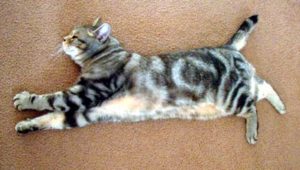Cat Litter and Carpet
 Cat litter, particularly clumping cat litter, can be quite an annoyance when it gets into carpet. Beyond simple annoyance, dirty cat litter in the carpet can be a source of health issues and can even encourage a cat to soil the carpet further.
Cat litter, particularly clumping cat litter, can be quite an annoyance when it gets into carpet. Beyond simple annoyance, dirty cat litter in the carpet can be a source of health issues and can even encourage a cat to soil the carpet further.
Some people will tell you that your pet and polyester carpet (and other types of carpet too) don’t mix. With the right strategy, that’s simply not the case. The simplest method of dealing with cat litter problems with your carpet is to prevent most of the problem in the first place and to localize what remains. To this end it’s a good idea to place the litter box in a crawl space, a closet, or some similar out-of-the-way area with very few ways that the cat can reach it.
Most carpet and home stores have small carpet remnants or carpet samples that you can buy. Place a layer of these remnants under and around the litter box for at least three feet from the litter box. Whenever these carpet pieces become dirty with litter take them outside and shake and beat them out, or if this is not possible then vacuum these pieces frequently.
A cut pile carpet or a similar medium-length carpet is better for this purpose than a shorter or loop pile, since the goal with these fragments it to catch excess litter from the cat’s paws before it gets tracked elsewhere. On the other hand, a longer length carpet pile can prove more difficult to clean and can hide the extent of the built-up litter, encouraging disease and pests. So a medium-length carpet is best.
The next important point to know is how critical it is to change the litter frequently. Just as many of us are uncomfortable using a filthy bathroom, so too are cats. If the litter box is too dirty, your feline friend will look for other out-of-the-way places to go potty. The exact frequency depends on the age, health, and number of your cats. With a kitten you may need to change a litter box only once a week, while an elderly or ill cat may require much more frequent action.
If dirty litter has been tracked around your home or office, those trails may be the first places a cat may look when trying to find a new bathroom, as well as any other spot that smells like a litter box or is hidden from view. In spite of all your efforts, kitty litter will still find its way into the carpet, so it’s important to clean it up regularly.
To do so, start with your vacuum cleaner. Note that using a broom or brush attachment will drive the litter deeper into the carpet, so avoid using these tools. Instead, use the hose with the corner attachment to get the highest suction power possible, and try hovering over the litter first rather than pushing down into the carpet. It’s also important to note that while hand vacuums may get up the worst of a larger litter spill, they lack the suction power of a regular vacuum and they can also drive the litter deeper.
After vacuuming you can also try using the sticky side of duct tape to pick up remaining dust and some hidden litter pieces, but depending on the power of your vacuum and the thoroughness of the vacuuming job, this may be of little value.
After you’ve cleaned up used litter, make sure that you lightly spray the area with a deodorizer and possibly a carpet protector. This will help prevent your cat from identifying the area as an alternate litter box. Please keep in mind that some sprays can actually make your carpet dirty by serving as a dirt attractant, so you may want to avoid this step unless the litter was smelly or obviously dirty.
Of course, you can avoid most of the trouble cleaning dirty litter by simply having Commercial Steam Team clean your carpets and upholstery. Our qualified professionals will make all your carpet clean and fresh! For the best in pet safe carpet cleaning call Commercial Steam Team today at 952-224-7222 to see how we can transform your carpets.
